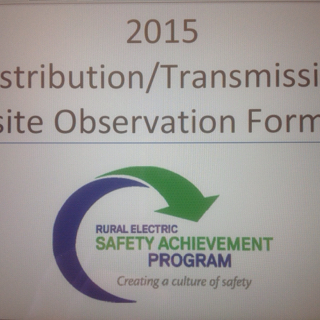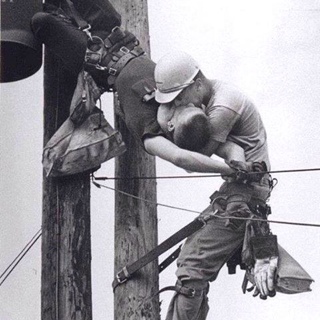Title Page
-
Cooperative Name
-
Location
-
- Main Facility
- Outpost
-
Conducted on
-
Prepared by
Section 15: Crew Visits
-
15.1 System work crews can be located and are available for interviews (Personnel working overhead, underground, right of way, etc.) or work observation either on the job site or other suitable locations. <br><br>ref: 1910.269
-
15.2 According to employee interviews, communication is routinely established with the office dispatcher or supervisor at each job site. <br>Criteria:<br>* Communication occurs before moving to the next job site or upon arrival.<br>* If the primary method of communication is weak in certain areas, an alternate method is planned in the event of an emergency.<br>
-
15.3 A designated person is in charge at each worksite.<br><br>ref: 1910.269(c)
-
15.4 A thorough job briefing is conducted before each job assignment by the person in charge, documented and all employees are clear and understand their assignments. The Job Briefing document is clearly signed by all employees on site. <br><br>ref: 1910.269(c)(1)
-
15.5 Appropriate tools and equipment are available, or in use as the job requires.<br><br>Criteria:<br>* All equipment relevant to the job and voltages, such as rubber cover ups, grounds, mechanical jumpers, arc rated clothing, face shields, etc.
-
15.6 Operational voltage detection devices are available on each job site to determine the observer and nominal voltages. <br><br>ref: 1910.269(n)(5)
-
15.7 An adequate supply of traffic control devices are available or are in use as required.<br><br>ref: MUTCD
-
15.8 Employees are knowledgeable regarding work site emergency actions. <br><br>ref: 1910.269(a)(3)
-
15.9 Line personnel are knowledgeable, when questioned individually, about when rubber gloves shall be used.<br><br>Criteria:<br>* Personnel shall have knowledge of system distribution voltages and associated minimum approach distances.<br>* Co-op Safety Manuals that provide for cradle-to-cradle, ground-to-ground, lock-to-lock gloving rules are in compliance with MADs (not a program requirement).<br><br>ref: Safety Rules
-
15.10 Line personnel are knowledgeable, when questioned individually, about when rubber sleeves shall be used. <br><br>ref: Safety Rules
-
15.11 Supervisors and crew foreman are clear and consistent about when rubber gloves and sleeves shall be used.<br>Criteria:<br>* Supervisors and Crew Leads understand the system Safety Manual relating to MAD and/or their application of cradle-to-cradle, ground-to-ground, lock-to-lock, rule for gloves and sleeves as applicable. <br><br>ref: Safety Manual
-
15.12 Line personnel are knowledgeable, when questioned individually, about when personal grounds shall be used.<br><br>ref: Safety Rules
-
15.13 Line personnel are able to explain the proper steps for installing personal grounds. <br><br>ref: 1910.269(n)(2)
-
15.14 Line personnel are knowledgeable, when questioned individually, about when vehicle/equipment ground and/or barricading are required to be used.<br><br>ref: 1910.269(o)(4)(vi)
-
15.15 Line Personnel are able to explain the preferred methods of vehicle/equipment grounding or methods used for barricading. <br><br>ref: 1910.269(o)(4)(vi)
-
15.16 Line personnel can explain the proper use of traffic control devices as required for the speed and volume of traffic through typical work zones. <br>Criteria:<br>* In states where flagger certification is required, evidence of the affected employee training is available when requested.<br>* In all other states, affected employees confirm, when questioned, that traffic control and flagger training are regular safety topics. <br><br>ref: MUTCD
-
15.17 Supervisors and crew foremen are clear and consistent about the procedures for installing personal and vehicle/equipment grounds and/or barricading. <br><br>ref: 1910.269(o)(4)(vi)
-
15.18 Line personnel are knowledgeable about line clearance procedures required at their system.<br><br>ref: RUS-NESC
-
15.19 Supervisors and crew foremen are clear and consistent in their explanation of line clearance procedure required at their system.
-
15.20 If work is observed, work in progress is in compliance with local safety rules and utility safe work practices. (i.e. Did they check/inspect all rubber goods prior to use?)<br><br>ref: Safety Rules
-
15.21 Line personnel are knowledgeable when questioned about inspection and proper adjustment of climbing tool and 100% fall protection.
-
15.22 The person-in-charge is clear and consistent when questioned about inspection and proper adjustment of climbing tools and 100% fall protection. <br><br>ref: ASTM 887.12 or higher, ref: ANSI Z359.1-2007 or later
-
15.23 Employees have understanding of hazard assessment related to heat energy and the Arc rated clothing required.<br>
Section 15: Summary
-
15.24 The overall evaluation of the onsite field observation team for this section of the assessment is as follows:<br>Criteria: <br>* Strong performance - Questions evaluated as exceeds or satisfies all requirements.<br>* Satisfactory performance - Questions evaluated as satisfies all requirements, could be a small number evaluated as exceeds.<br>* Generally satisfactory with minor areas for improvement - Questions evaluated as satisfies all or most requirements, improvement areas are minor<br>* Key attention areas for improvement - Questions evaluated as partially satisfies or fails to satisfy requirements in important improvement areas<br>
IAEC Safety Personnel Signature
-
John Dvorak
-
Matt Pociask
-
Sam Yarham







